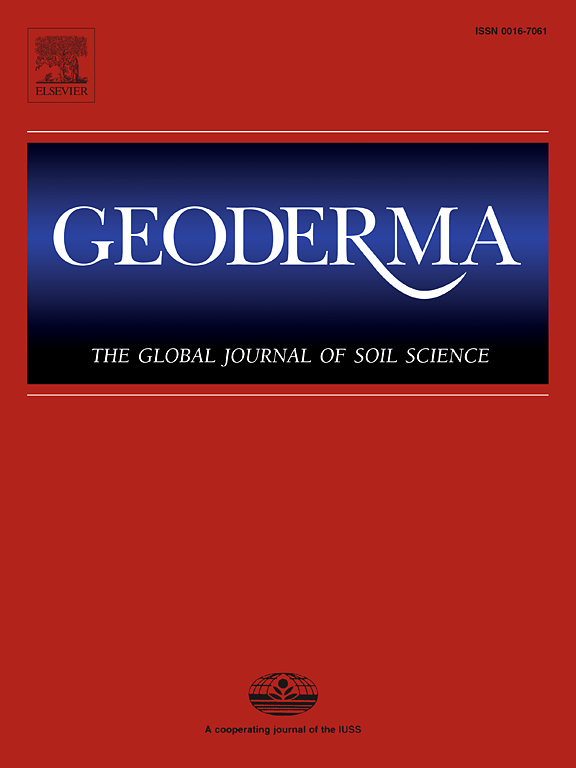Driving factors of variation in fertilizer nitrogen recovery efficiency in maize cropping systems across China and its microbial mechanism
IF 6.6
1区 农林科学
Q1 SOIL SCIENCE
引用次数: 0
Abstract
Maize (Zea mays L.) fertilizer nitrogen (N) recovery efficiency (FNRE) shows regional differences in China, and is more strongly affected by soil properties than by climate. However, how soil factors regulate maize FNRE is poorly understood. Herein, 15N tracer pot experiments combined with absolute microbial quantification sequencing were conducted using eight soils covering the main maize cropping systems from northern to southern China. The aim was to elucidate which soil factors affect maize FNRE and identify their optimal range for maximizing FNRE while minimizing N loss. Our results show that soil pH, soil organic matter (SOM), and clay and sand contents were the key factors affecting maize biomass and FNRE across the eight tested soils. Maize biomass and FNRE had parabolic relationships with soil pH, SOM, clay, and sand contents, whereas N loss displayed the opposite trend. The highest maize biomass and FNRE and lowest fertilizer N loss were in the soils with pH of 6.50–6.62, SOM level of 35.25–46.90 g kg−1, clay content of 41.12 %–44.42 %, and sand content of 17.71 %–23.41 %. Under these soil conditions, maize growth and soil N retention capabilities exhibited a high degree of coordination. Bacterial communities differed significantly among the soils, sharing the same soil drivers as maize biomass and FNRE. The abundance of N cycling genes (nasA, narI, narJ, nrfA, and nrfB) involved in dissimilatory nitrate reduction to ammonium (DNRA) was positively correlated with FNRE and negatively correlated with fertilizer N loss, suggesting that DNRA may contribute to soil N retention and enhance FNRE by affecting substrates for nitrification and denitrification. Our study demonstrates that soil pH, SOM, and texture are three key factors driving FNRE variation in maize cropping systems across China, and high microbial-driven DNRA may account for maximum maize FNRE. These findings highlight the importance of tailored FNRE enhancement strategies based on soil characteristics.
中国玉米种植系统肥料氮素回收效率变化的驱动因素及其微生物机制
玉米(Zea mays L.)的肥料氮(N)回收效率(FNRE)在中国存在地区差异,并且受土壤特性的影响比受气候的影响更大。然而,人们对土壤因素如何调控玉米氮肥回收率知之甚少。在此,研究人员利用覆盖中国从北方到南方主要玉米种植系统的八种土壤,进行了 15N 示踪剂盆栽实验和绝对微生物定量测序。目的是阐明哪些土壤因子会影响玉米的全氮素还原反应,并确定其最佳范围,以便在最大限度地提高全氮素还原反应的同时减少氮的损失。结果表明,在八种测试土壤中,土壤 pH 值、土壤有机质(SOM)、粘土和沙的含量是影响玉米生物量和全氮肥还蛋白率的关键因素。玉米生物量和秸秆还田率与土壤 pH 值、土壤有机质、粘土和沙的含量呈抛物线关系,而氮的流失则呈现相反的趋势。在 pH 值为 6.50-6.62、SOM 含量为 35.25-46.90 g kg-1、粘土含量为 41.12 %-44.42 % 和含沙量为 17.71 %-23.41 % 的土壤中,玉米生物量和 FNRE 最高,肥料氮损失最低。在这些土壤条件下,玉米生长和土壤保氮能力表现出高度的协调性。不同土壤中的细菌群落差异显著,它们与玉米生物量和 FNRE 具有相同的土壤驱动力。参与硝酸盐还原成氨(DNRA)的氮循环基因(nasA、narI、narJ、nrfA 和 nrfB)的丰度与 FNRE 呈正相关,而与肥料氮损失呈负相关,这表明 DNRA 可通过影响硝化和反硝化的基质来促进土壤氮的保留并增强 FNRE。我们的研究表明,土壤 pH 值、SOM 和质地是驱动中国玉米种植系统 FNRE 变化的三个关键因素,而微生物驱动的高 DNRA 可能是玉米 FNRE 最大化的原因。这些发现凸显了根据土壤特性量身定制 FNRE 增强策略的重要性。
本文章由计算机程序翻译,如有差异,请以英文原文为准。
求助全文
约1分钟内获得全文
求助全文
来源期刊

Geoderma
农林科学-土壤科学
CiteScore
11.80
自引率
6.60%
发文量
597
审稿时长
58 days
期刊介绍:
Geoderma - the global journal of soil science - welcomes authors, readers and soil research from all parts of the world, encourages worldwide soil studies, and embraces all aspects of soil science and its associated pedagogy. The journal particularly welcomes interdisciplinary work focusing on dynamic soil processes and functions across space and time.
 求助内容:
求助内容: 应助结果提醒方式:
应助结果提醒方式:


